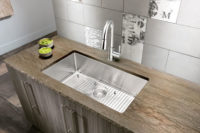
With the multitude of sink options available, it’s important for fabricators to be able to navigate through them to find the ideal model for each unique countertop installation.
Many fabricators today are charged with recommending sinks that complement their clients’ new stone countertops. Stainless steel is the sink material of choice for most homeowners, as it offers a perfect match for any stone and never goes out of style. But while customers may be confident in their material choice, they are often less certain about the shape, style and size of sink that will fit the needs of their kitchen.
With the multitude of sink options available, it’s important for fabricators to be able to navigate through them to find the ideal model for each unique installation. The following tips are designed to simplify the selection process and help fabricators easily find the right sink for each customer.
Durability, dependability
Durability is essential with stone countertop installations, as customers expect their investment to last for years without having to replace any of the components. Since stainless steel does not crack, chip or discolor, fabricators can assure customers that it is a superior sink material. Quality stainless steel sinks are constructed of 300 series stainless steel, which provides higher resistance to rust and a bright, beautiful finish, while minimizing corrosion.
Another key factor to consider is the gauge or thickness of the steel. Residential sinks usually range from 18 gauge to 22 gauge and, as many fabricators know, the lower the gauge number, the thicker the steel and sturdier the sink. Choosing an inferior sink of thinner stainless steel can affect the homeowner’s satisfaction within the first six months, as the finish and sound will create noticeable deficiencies. To ensure satisfied customers today and tomorrow, stainless steel sinks in 18 or 20 gauge are recommended.
By selecting stainless steel sinks from reputable manufacturers that offer quality products constructed of the appropriate thickness and type with consistent material and dimensional integrity, fabricators can rest assured that they are delivering a quality sink paired with their quality top.

Durability is essential with stone countertop installations, as customers expect their investment to last for years without having to replace any of the components.
Since installing the sink is often the final step of the project, it’s best to work with manufacturers who offer on-time delivery with quality customer service to ensure a smooth, efficient process without costly delays. To ensure that the sink will be there when you need it, choose manufacturers that have a wide variety of sinks in stock and readily available, dedicated customer service personnel, as well as service and support. It is also important to work with manufacturers that offer a long-term warranty on their products to ensure customer satisfaction for years to come.
Undermount versus top-mount
The decision between undermount and top-mount sinks should be based on the countertop material, customer preference and price. According to designers and fabricators, nearly every homeowner who chooses a stone countertop selects a stainless steel, undermount sink (reference from “Kitchens.com: Trends, Designer Comments”). However, since both undermount and top-mount models have unique advantages, fabricators should educate customers on the benefits of each option.
Undermount or recessed sinks are installed under a countertop, which creates a seamless look and allows for easier cleaning, since debris can be brushed off the countertop and into the sink bowl without sink deck interference. Since an undermount is a permanent installation, quality is key when selecting the sink - as it typically cannot be removed without damaging the countertop.
Another option to present customers is top-mount or drop-in sinks, which have rolled and finished edges. A key benefit to a drop-in sink style is that it can be replaced without dismantling or possibly destroying the original countertop, thus making remodeling easier down the road. Available in many standard sink base sizes, top-mount sink models can optimize an existing cut-out. Also, with soft countertop stone materials, such as certain marbles, a top-mount sink can help protect the edges of the counter.
Sharing insights such as these not only increases the current job’s value, but also builds the fabricator’s reputation as an industry expert and helps increase referrals and profitability from repeat customers.
Style, size and depth
Like countertops, sinks combine form with function, so fabricators should guide homeowners to the appropriate style, size and depth for their needs. First, help them determine the primary use of the sink. For example, will the customer use it for meal preparation, washing dishes or as a secondary sink for entertaining? Once armed with this information, the fabricator can assist homeowners in choosing a single-, double- or triple-bowl sink with the proper dimensions and depth.
Double-bowl sinks, which offer two separate work compartments, are the most common sink configuration as they increase efficiency for multiple users in the kitchen. Some double bowl models feature a second bowl in a different size or depth that can either be specified for the left or right side, depending on the customer’s preference. Single-bowl sinks, on the other hand, continue to grow in popularity due to today’s non-traditional use of the kitchen sink - less washing and more rinsing of dishes before loading them into the dishwasher. In addition, smaller single bowls can be used as a secondary prep sink in a bar area or kitchen island. Triple-bowl models, which usually have two larger bowls with one small bowl in the center (often housing the garbage disposal), provide versatility by offering enough space for several people to perform different tasks around the sink together. In addition to determining how the sink will be used, fabricators should also discuss the amount of space it will occupy in order to choose the ideal model for the homeowner’s space.
Most residential sinks range from 6 to 10 inches in depth. The most common depth is 8 inches, but the 10-inch depth models have increased in popularity in recent years. As with the style, the depth should be determined by the homeowner’s preference and the function of the sink.
Working with manufacturers that offer a wide variety of sink styles, sizes and depths makes finding the right model for the customer a quick and easy process. Fabricators can also inform consumers that stainless steel sinks that do not have straight side walls and flat bottoms help protect delicate stemware and China, while providing maximum capacity.
Suppressing sound
One feature that should not be overlooked when selecting a sink is sound suppression. Stainless steel sinks are available with insulation underneath, which helps to reduce noise during use. Most manufacturers offer sinks with different insulation options, such as a comprehensive undercoating or sound absorbing pads - or both - to assure a quiet, relaxed experience and, thus, a satisfied customer.
The finishing touch
For a lasting look, fabricators might want to guide homeowners to choose a sink with a durable, satin finish that offers timeless beauty, blending in scratches and any signs of use over time. A mirror or hammered finish sink, although attractive as a kitchen focal point, is only recommended for an area that encounters less activity, such as a wet bar or butler’s pantry. Choosing the appropriate finish for each customer’s sink ensures that the sink will maintain its look throughout the lifetime of the countertop.

Until recently, very few fabricators sold faucets, but this trend continues to grow as an increasing number of fabricators recognize that offering a complete sink solution can further build incremental profits.
Once the sink model is selected, fabricators can also help homeowners choose a faucet for a complete, coordinated look. Until recently, very few fabricators sold faucets, but this trend continues to grow as an increasing number of fabricators recognize that offering a complete sink solution can further build incremental profits.
Like sinks, faucets are available in a wide range of styles, finishes and price points. To simplify the selection process, some sink manufacturers also offer quality, affordable faucets, providing a one-stop-shop for the fabricator and ensuring a seamless look.
Accessories
After helping the homeowner choose his/her ideal sink style and complementary faucet, an additional way to increase both the customer’s satisfaction and the fabricator’s profits is to share accessory options for the sink. For example, some manufacturers offer accessories customized for each sink model, such as cutting boards that can be used over the bowls, bottom grids for protecting the bottom of the sink and strainers. Designed to complement each unique model, these accessories complete the sink presentation and add to the overall look and feel of the kitchen, while also adding to the fabricator’s profit on the job with incremental add-ons.
Ease of installation
To simplify the installation, fabricators should choose sinks that are equipped with mounting hardware for added convenience. Most quality stainless steel sinks include countertop cut-out templates and complete installation instructions to help fabricators install sinks quickly and easily, thus allowing the fabricator to move on to the next project and the satisfied homeowner to start using his/her new kitchen without delays.
Care and cleaning
Finally, share tips with the homeowner for day-to-day cleaning of both the countertop and the sink. For the stainless steel sink, the best approach is to apply a mild dishwashing detergent with a soft sponge or fiber brush, rinse with clear water and wipe dry. Additionally, there are products on the market designed specifically for cleaning stainless steel. It is important to note that chlorides, which are found in most soaps, detergents, bleaches and cleansers, can be too aggressive for stainless steel if left on the surface for an extended period of time. Therefore, the sink should be thoroughly rinsed after using a cleaning agent that contains chlorides. By sharing tips for proper care and cleaning, fabricators can avoid call-backs and ensure customer satisfaction with a sink that maintains its quality throughout its life.
Although kitchen sink styles are ever-evolving, fabricators can provide homeowners with the insight they need to get the right sink for their homes. A homeowner’s decision to upgrade to a higher quality sink creates an opportunity for the fabricator to provide the customer with the ideal product for his/her needs, while creating a larger profit in the process.





